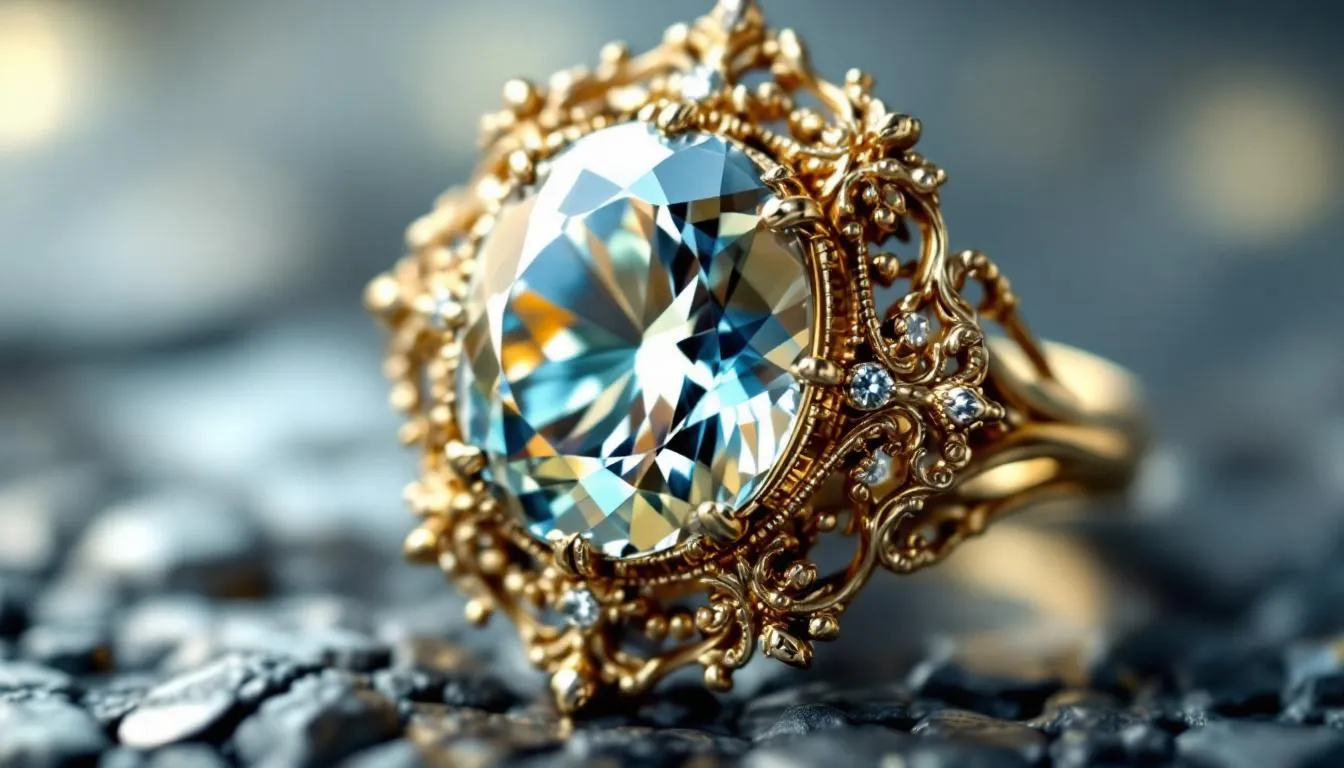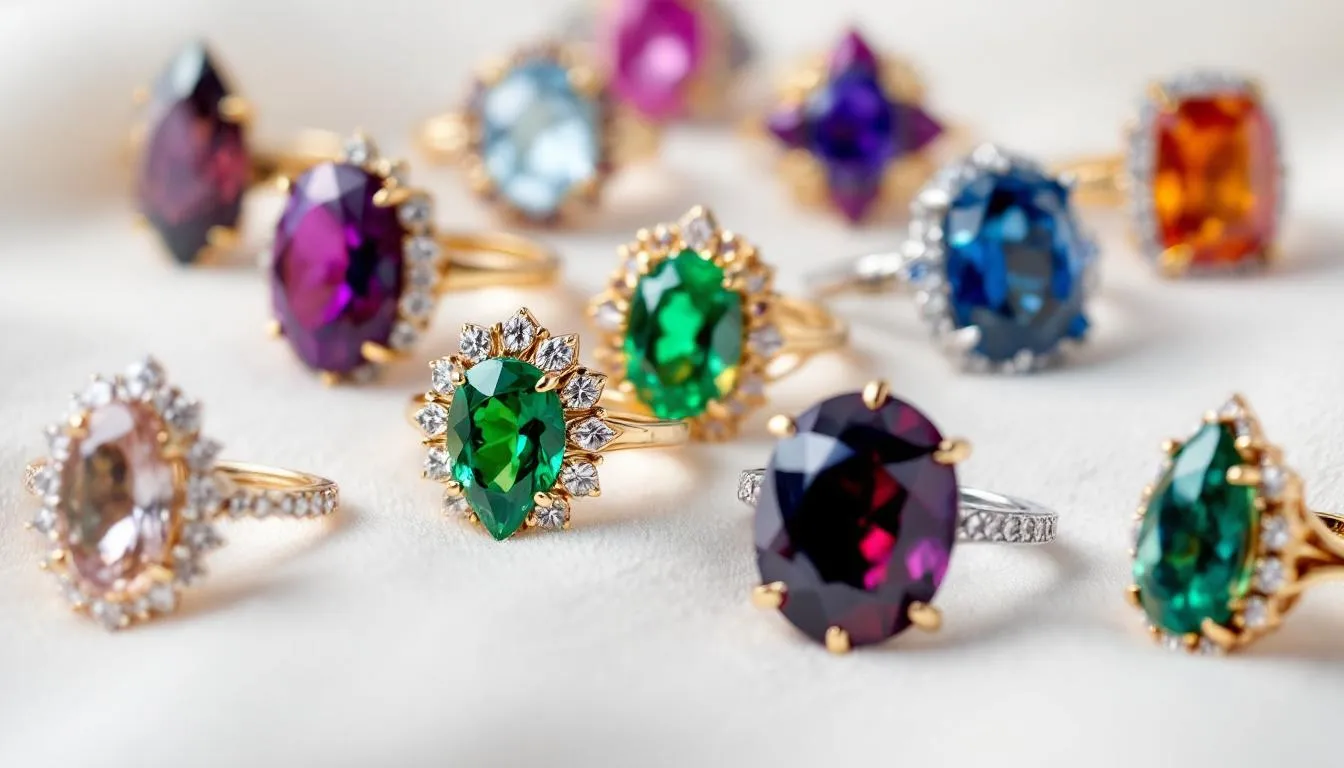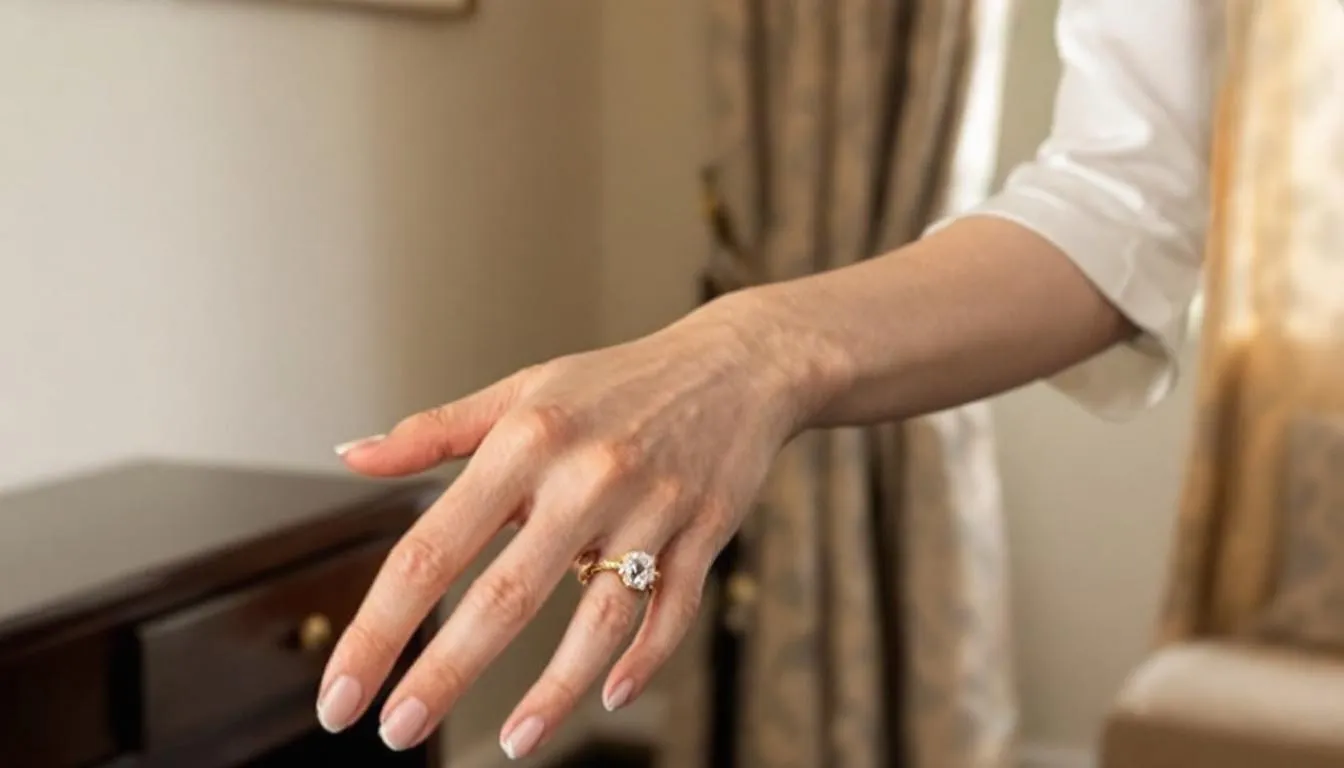
What Is a Cocktail Ring: Complete Guide to Statement Rings
Bold, dramatic, and designed to command attention—cocktail rings represent the ultimate expression of personal style through jewelry. These oversized, ornate rings have captivated fashion enthusiasts for nearly a century, transforming from symbols of rebellion during the American Prohibition era into timeless statement pieces that continue to define glamour and sophistication today.
Whether you’re drawn to their rich history, fascinated by their intricate designs, or simply want to understand how to incorporate these show-stopping pieces into your jewelry collection, this comprehensive guide will answer the question “what is a cocktail ring” while exploring everything from their rebellious origins to modern styling techniques.
What Is a Cocktail Ring?
A cocktail ring is fundamentally defined as a bold, oversized ring designed to serve as the focal point of any jewelry ensemble. These rings typically feature large center gemstones or elaborate clusters of smaller stones set in ornate metalwork that covers a significant portion of the finger. Unlike engagement rings or wedding rings, cocktail rings are purely fashion statements—pieces of jewelry created for self-expression rather than symbolic commitment.
The defining characteristics that distinguish cocktail rings from other types of rings include their maximalist design philosophy, substantial size, and attention-grabbing aesthetic. While engagement rings traditionally focus on a single diamond with understated elegance, cocktail rings embrace colorful gemstones, intricate patterns, and elaborate settings designed to spark conversation and showcase the wearer’s personal style.
These statement rings serve as versatile accessories that can elevate both formal evening wear and casual outfits, making them popular choices for women who appreciate bold pieces that reflect their personality and fashion sensibilities.

History and Origin of Cocktail Rings
The fascinating story of cocktail rings begins in the roaring 1920s during the American Prohibition era, when the manufacture and sale of alcohol were illegal throughout the United States. This period of social rebellion and cultural transformation provided the perfect backdrop for the emergence of these bold jewelry pieces.
During Prohibition, women began frequenting illegal speakeasies—secret establishments where cocktails flowed freely despite the federal ban on alcohol. These clandestine gathering places became symbols of liberation and defiance, particularly for women who had recently gained the right to vote and were increasingly asserting their independence in society.
The tradition of wearing cocktail rings emerged from this culture of rebellion. Women would don these elaborate, oversized rings as symbols of their newfound freedom and as conversation pieces during cocktail parties. The rings served multiple purposes: they drew attention to the hand holding a forbidden cocktail, symbolized the wearer’s willingness to break societal rules, and demonstrated financial independence and personal style.
The name “cocktail ring” directly derives from this association with cocktail party culture of the era. These special occasions called for bold fashion statements, and women embraced the opportunity to wear jewelry that was as daring and unconventional as their social activities.
The Art Deco movement, which flourished during the 1920s and 1930s, heavily influenced cocktail ring design aesthetics. This artistic style emphasized geometric patterns, bold colors, and luxurious materials—all characteristics that became hallmarks of cocktail ring design. The movement’s focus on modernity and rejection of traditional Victorian sensibilities perfectly aligned with the rebellious spirit that cocktail rings represented.
One crucial tradition established during this era was wearing cocktail rings on the right hand, specifically to distinguish them from engagement and wedding rings worn on the left ring finger. This placement reinforced their role as fashion accessories rather than symbols of romantic commitment, while ensuring maximum visibility during social gatherings.
By the 1940s and 1950s, cocktail rings had evolved beyond their subversive origins to become standard accessories for elite social events and formal occasions. Hollywood icons like Elizabeth Taylor and socialites such as Zelda Fitzgerald helped cement their association with glamour and high society, ensuring their enduring popularity in fashion circles.
Key Features and Characteristics
Cocktail rings are immediately recognizable due to their distinctive size and elaborate construction. These statement pieces typically cover a significant portion of the finger, often extending from the knuckle area to the base of the finger, creating an unmistakable presence that serves as the focal point of any jewelry ensemble.
The elaborate metalwork found in cocktail rings distinguishes them from simpler ring designs. Traditional pieces feature intricate filigree, detailed engravings, and complex settings that showcase the craftsmanship of skilled jewelers. These ornate elements create visual interest and depth, ensuring the ring captures and reflects light from multiple angles.
Common gemstones used in cocktail rings span a wide spectrum of colors and varieties. While diamonds remain popular choices, many designs feature vibrant colored gemstones including rubies, emeralds, sapphires, amethyst, opals, aquamarine, and blue topaz. The use of colorful gemstones allows wearers to match their rings to specific outfits or express personal color preferences.
The maximalist aesthetic that defines cocktail rings embraces bold combinations of materials, colors, and textures. Unlike minimalist jewelry that emphasizes simplicity, these pieces celebrate abundance and visual impact through layered designs, multiple stone settings, and dramatic proportions.

Types of Cocktail Rings
Several distinct styles have emerged within the cocktail ring category, each offering unique aesthetic appeal and design characteristics.
Ballerina rings represent a specific subset of cocktail rings featuring a large center gemstone surrounded by a tutu-like halo of baguette-cut diamonds or other stones. This design creates a radiating pattern that resembles a ballerina’s skirt, hence the name. These rings became particularly popular in the mid-20th century and remain sought-after vintage pieces today.
Multi-stone cluster designs feature groups of smaller stones arranged to create the visual impact of a single large gemstone. These multi stone settings allow for creative combinations of different colored gemstones while maintaining the bold aesthetic cocktail rings require. Cluster designs often prove more affordable than single large center gemstone alternatives while offering equally impressive visual results.
Geometric Art Deco inspired patterns reflect the influence of the 1920s artistic movement through angular designs, symmetrical layouts, and bold contrasts between different materials. These vintage style rings often incorporate step-cut gemstones, linear patterns, and architectural elements that create sophisticated, structured appearances.
Contemporary designers continue creating modern interpretations alongside vintage reproduction pieces, ensuring cocktail rings remain relevant for today’s fashion preferences while honoring their historical roots.
Materials and Metals
The choice of metal significantly impacts both the appearance and value of cocktail rings, with several options offering distinct advantages for different preferences and budgets.
Platinum stands as the traditional choice for authentic vintage cocktail rings and remains highly prized for its durability, resistance to tarnishing, and lustrous white appearance. This precious metal provides an ideal backdrop for showcasing colorful gemstones while offering the strength needed to secure large stones in complex settings. Platinum’s rarity and desirable properties make it one of the more expensive metal choices.
Gold options provide versatility through three main variations: yellow gold offers warm, traditional appeal that complements many skin tones and gemstone colors; white gold provides a modern alternative to platinum with similar aesthetic properties at a lower cost; and rose gold has gained popularity for its romantic, vintage-inspired appearance that pairs beautifully with pink and warm-toned gemstones.
Two-toned metal combinations create visual interest through strategic mixing of different metal colors within a single ring design. Common combinations include white gold and yellow gold, or platinum and rose gold, creating contrast that highlights different elements of the design while adding sophisticated complexity.
For those seeking more budget-friendly alternatives, sterling silver and gold vermeil (sterling silver with gold plating) offer accessible entry points into cocktail ring ownership. While these metals may require more maintenance and careful handling, they allow fashion enthusiasts to enjoy the cocktail ring aesthetic without the investment required for precious metal pieces.
When considering durability, harder metals like platinum and gold alloys provide better long-term wear resistance compared to softer ones like pure silver. This consideration becomes particularly important for cocktail rings due to their size and the potential for catching on objects during everyday wear.

How to Wear Cocktail Rings
The traditional placement for wearing cocktail rings involves the right hand, specifically the ring finger or middle finger. This positioning stems from their historical origins when women wanted to distinguish these fashion pieces from wedding bands and engagement rings worn on the left ring finger. The right-hand placement also ensures maximum visibility during social interactions, particularly when holding drinks or gesturing during conversations.
Modern conventions offer much greater flexibility regarding finger and hand placement. Contemporary wearers often choose positioning based on comfort, personal preference, and the specific ring design. Some prefer the middle finger for larger rings that require more space, while others opt for the ring finger to maintain traditional placement. Adjacent fingers can also work well depending on the ring’s size and the wearer’s hand proportions.
When deciding whether to wear cocktail rings alone or stack them with other rings, consider the size and design of your primary piece. Most cocktail rings work best as standalone statement pieces due to their substantial presence and ornate designs. However, smaller cocktail-style rings can be successfully paired with complementary pieces, provided the overall combination doesn’t become overwhelming or uncomfortable.
Ring size considerations become crucial with cocktail rings due to their substantial dimensions. The larger surface area means proper fit is essential for comfort during extended wear. Many wearers prefer a slightly looser fit than they would choose for everyday rings to accommodate the additional coverage and prevent pinching during normal hand movements.
Styling with Different Occasions
Formal events represent the ideal setting for showcasing cocktail rings in their full glory. Pair these bold pieces with cocktail dresses, evening gowns, or sophisticated formal wear where the ring can serve as a focal point without competing with overly busy patterns or excessive accessories. The glamour and elegance of formal occasions perfectly complement the statement-making nature of these rings.
Special occasions such as dinner parties, theater performances, or upscale social gatherings provide excellent opportunities for wearing cocktail rings. These events typically involve environments where guests appreciate fashion and style, making them perfect venues for displaying these conversation-starting pieces.
For everyday wear and casual outfits, smaller or more understated cocktail ring designs can effectively elevate simple ensembles. A vintage-inspired piece can transform jeans and a blouse into a more polished look, while careful selection ensures the ring enhances rather than overwhelms casual styling.
Professional settings require judicious selection when incorporating cocktail rings into business attire. Choose refined pieces with classic gemstones and understated elegance rather than the most dramatic options in your collection. The goal is to add sophisticated style without appearing inappropriate for workplace environments.
Cocktail Rings vs. Other Ring Types
Understanding the distinctions between cocktail rings and other ring categories helps clarify their unique role in jewelry collections and styling choices.
Cocktail rings vs. engagement rings reveals fundamental differences in purpose, design, and symbolism. While engagement rings traditionally symbolize romantic commitment and future marriage, cocktail rings serve purely aesthetic purposes as fashion accessories. Engagement rings typically feature single diamonds in classic settings designed for daily wear, whereas cocktail rings embrace bold designs, colorful gemstones, and ornate settings intended for special occasions.
Wedding rings and wedding bands differ from cocktail rings in their symbolic significance and practical design considerations. Wedding bands represent marital commitment and are designed for continuous daily wear, requiring durability and comfort above visual impact. Cocktail rings prioritize dramatic appearance and statement-making potential over everyday practicality.
The relationship between cocktail rings and statement rings creates some overlap, as cocktail rings represent a specific subset of the broader statement ring category. While all cocktail rings qualify as statement rings due to their bold, attention-getting designs, not all statement rings are cocktail rings. The distinction lies in the specific historical origins, traditional styling, and design characteristics that define authentic cocktail ring aesthetics.
Some contemporary couples choose to use cocktail rings as non-traditional engagement rings, appreciating their unique character and the opportunity to select from a wider variety of gemstones and designs. This trend reflects changing attitudes toward traditional jewelry conventions and the desire for more personalized expressions of commitment.
Choosing the Right Cocktail Ring
Selecting the perfect cocktail ring requires careful consideration of multiple factors that influence both aesthetic appeal and practical wearability.
Personal style preferences should guide your selection process, as cocktail rings represent significant fashion investments that should align with your overall aesthetic sensibilities. Consider whether you gravitate toward vintage-inspired designs, contemporary interpretations, or specific artistic movements like Art Deco. Your existing jewelry collection can provide clues about metal preferences, gemstone colors, and design complexity that appeal to you.
Gemstone choices significantly impact both the appearance and cost of cocktail rings. Consider which colors complement your skin tone and wardrobe preferences. Warm-toned stones like rubies, garnets, and amber work well with yellow or rose gold settings, while cool-toned options like sapphires, emeralds, and aquamarine pair beautifully with white gold or platinum. Popular choices include classic options like diamonds and sapphires, as well as more unique selections like opals or vintage-inspired amethyst.
Ring size and finger comfort require special attention with cocktail rings due to their substantial dimensions. Consider having your finger professionally sized, accounting for the fact that larger rings may require slightly different sizing than traditional bands. Factor in seasonal variations in finger size and the intended frequency of wear when making sizing decisions.
Quality and budget considerations involve balancing desired features with financial constraints. Determine whether you prioritize large center gemstones, precious metals, vintage authenticity, or contemporary craftsmanship. Research different price points and understand the factors that influence value, such as gemstone quality, metal purity, and construction techniques.
Intended occasions and frequency of wear should influence your selection strategy. If you plan to wear your cocktail ring frequently, prioritize comfort and durability. For special occasion pieces, you might emphasize visual impact over everyday practicality.
Caring for Your Cocktail Ring
Proper maintenance ensures your cocktail ring maintains its beauty and value while preventing damage that could compromise its structural integrity or gemstone security.
Cleaning guidelines vary depending on the specific gemstones and metals in your ring. Most cocktail rings benefit from gentle cleaning with warm water and mild soap, using a soft-bristled brush to remove accumulated dirt and oils from intricate settings. However, softer gemstones like opals or emeralds require special care to prevent damage, while harder stones like diamonds and sapphires tolerate more aggressive cleaning methods.
Storage recommendations focus on preventing scratches, impacts, and tangles with other jewelry pieces. Store cocktail rings individually in soft pouches or separate compartments to prevent metal-on-metal contact that could cause scratching. Ensure storage areas maintain stable temperature and humidity levels to prevent metal tarnishing or gemstone degradation.
When to remove rings includes activities that could subject them to harsh chemicals, extreme temperatures, or physical impacts. Remove cocktail rings before swimming in chlorinated water, using cleaning products, exercising, or performing manual tasks that could catch or damage protruding elements.
Professional maintenance and inspection schedules help identify potential problems before they become serious issues. Have your cocktail ring professionally cleaned and inspected annually, or more frequently if you wear it regularly. Professional jewelers can check prong security, identify loose stones, and address minor issues before they require major repairs.
Regular maintenance preserves both the aesthetic appeal and structural integrity of these valuable pieces, ensuring they continue making stunning fashion statements for years to come.

Conclusion
Cocktail rings represent far more than mere accessories—they embody a rich history of rebellion, liberation, and self-expression that continues to resonate with fashion enthusiasts today. From their origins in 1920s speakeasies to their current status as versatile statement pieces, these bold rings offer unique opportunities to showcase personal style while honoring a fascinating cultural legacy.
The beauty of cocktail rings lies in their versatility and ability to transform any outfit into a fashion statement. Whether you’re drawn to vintage Art Deco designs, contemporary interpretations, or the rich symbolism of colorful gemstones, there’s a cocktail ring perfectly suited to your aesthetic preferences and lifestyle needs.
Understanding the distinctions between cocktail rings and other jewelry types, along with proper styling and care techniques, empowers you to make informed decisions about incorporating these stunning pieces into your jewelry collection. From formal events to special occasions, the right cocktail ring serves as a conversation starter and confidence booster that reflects your unique personality and style sensibilities.
As you explore the world of cocktail rings, remember that the best choice is one that resonates with your personal aesthetic while considering practical factors like comfort, quality, and intended use. Whether you’re adding your first statement ring to your collection or expanding an existing ensemble of bold pieces, cocktail rings offer timeless appeal that transcends fleeting fashion trends.
